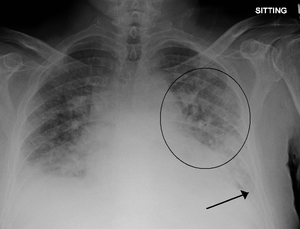
Pulmonary edema

Pulmonary edema is fluid accumulation in the tissue and air spaces of the lungs. It leads to impaired gas exchange and may cause respiratory failure. It is due to either failure of the left ventricle of the heart to remove blood adequately from the pulmonary circulation (cardiogenic pulmonary edema), or an injury to the lung parenchyma or vasculature of the lung (non-cardiogenic pulmonary edema). Treatment is focused on three aspects: firstly improving respiratory function, secondly, treating the underlying cause, and thirdly avoiding further damage to the lung. Pulmonary edema, especially acute, can lead to fatal respiratory distress or cardiac arrest due to hypoxia. It is a cardinal feature of congestive heart failure. The term edema is from the Greek οἴδημα (oídēma, 'swelling'), from οἰδέω (oidéō, 'I swell'). Pulmonary edema is fluid accumulation in the tissue and air spaces of the lungs. It leads to impaired gas exchange and may cause respiratory failure. It is due to either failure of the left ventricle of the heart to remove blood adequately from the pulmonary circulation (cardiogenic pulmonary edema), or an injury to the lung parenchyma or vasculature of the lung (non-cardiogenic pulmonary edema). Treatment is focused on three aspects: firstly improving respiratory function, secondly, treating the underlying cause, and thirdly avoiding further damage to the lung. Pulmonary edema, especially acute, can lead to fatal respiratory distress or cardiac arrest due to hypoxia. It is a cardinal feature of congestive heart failure. The term edema is from the Greek οἴδημα (oídēma, 'swelling'), from οἰδέω (oidéō, 'I swell'). Classically it is cardiogenic (left ventricular) but fluid may also accumulate due to damage to the lung. This damage may be direct injury or injury mediated by high pressures within the pulmonary circulation. When directly or indirectly caused by increased left ventricular pressure pulmonary edema may form when mean pulmonary pressure rises from the normal of 15 mmHg to above 25 mmHg. Broadly, the causes of pulmonary edema can be divided into cardiogenic and non-cardiogenic. By convention cardiogenic refers to left ventricular causes. Injury to the lung may also cause pulmonary edema through injury to the vasculature and parenchyma of the lung. The acute lung injury-acute respiratory distress syndrome (ALI-ARDS) covers many of these causes, but they may include:
